Brief History of Computer Games and Platforms Part 2: 1983-1986
Let's continue our history with the golden age of 8-bit computer games
![]() By: E. Bolognesi
By: E. Bolognesi
Published: 16 October 2021, 12:18 pm
I published the first part of this article precisely two years ago, it took a lot to complete the second part, but finally, it's here. I hope you will enjoy it!
In the first part of this story (1977-1982), we saw the Apple II dominating the gaming scene during the early years following the birth of the home computers. Of the three models released in 1977 - the Commodore PET, the TRS-80, and the Apple II - the machine designed by Steve Wozniak captured the game developers' interest more than the others. Many influential game creators such as Richard Garriott and Ken Williams fell in love with the Apple II and produced games for this machine. The Atari 8-bit series, released at the end of 1979, became only a second-choice despite better graphics/sound and specific gaming hardware. Companies like Sierra On-Line and Brøderbund were first developing their original titles for the Apple II and only later ported them to other platforms.
But things were changing; in fact, 1982 was a pivotal year for the computer industry, perhaps as important as 1977.
In 1982 IBM launched the first MS-DOS powered IBM PC. It was costly and targeted to business users - and not suitable for games. However, It was a commercial success, and, as we know, it will be the final winner of this race, but not until several years later.
Other computers released in 1982 include the Oric-1, the Dragon 32, and the BBC micro - announced in December 1981 but started to be sold in 1982. The market was exploding.
But most importantly, between spring and summer 1982, two new models debuted almost simultaneously (though in different parts of the world): the ZX Spectrum and the Commodore 64. They represented a revolution to the home computer market and, most importantly, the history of video games. This is clear in the chart below, which shows the number of games released per year for each platform. The red bar indicates the Commodore 64 games, and the green bar the ZX Spectrum titles. Pretty straightforward, right?
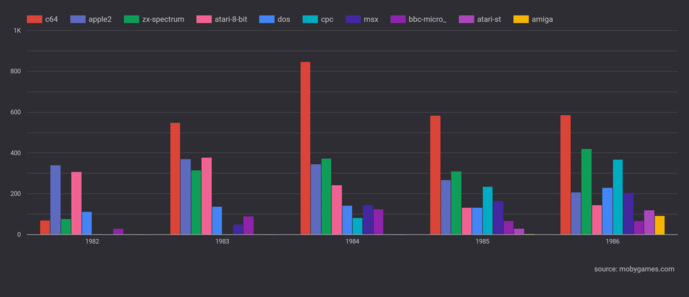
This article will begin with 1983 and end in 1986, discussing what I think can be easily defined as the "golden age of 8-bit computer games".
1983 - The Home Computers War
Interestingly, the biggest rival of the Commodore 64 during the Xmas season of 1982 is a computer that I haven't mentioned yet: the TI-99/4A. The 16-bit machine made by Texas Instruments outsold the C64 in that period. This fact started the so-called home computer wars. Commodore's boss Jack Tramiel decided to obliterate Texas Instruments with an aggressive pricing strategy, and he did it. During 1983 Texas Instruments lost hundred of millions and decided to exit the home computers market.
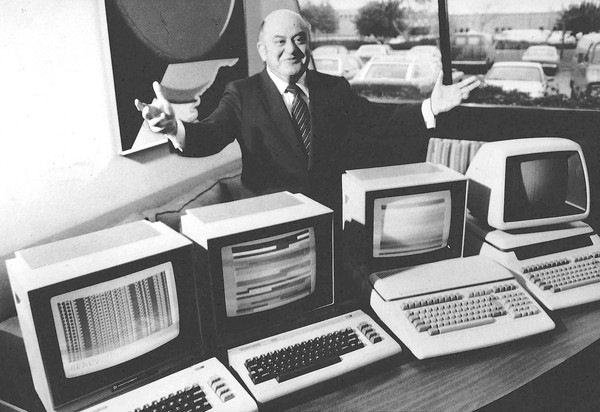
In 1983 the Commodore 64 became the best-selling home computer. This would soon start to impact the games market; let's see how.
Electronic Arts, founded in 1982 by a former Apple employee, Trip Hawkins, released its first games in 1983, and some of them were real gems:
Pinball Construction Set, created by Bill Budge, was the first "construction set" ever made, and it was developed for the Apple II. For the first time, children and adults were able to build their own videogame without programming knowledge. What Budge was able to achieve on a 48k 8-bit computer was incredible. Steve Wozniak himself defined this game as "the greatest program ever written for an 8-bit machine".
Another title released by EA in 1983 was M.U.LE., designed by Dan Bunten. It was a brilliant multiplayer economic/strategy game where four players were able to play simultaneously. The original version was developed for the Atari 8-bit, and it made use of the four joysticks ports of these models. It was not as successful as Pinball Construction Set, but many critics now consider it one of the best multiplayer games ever created.
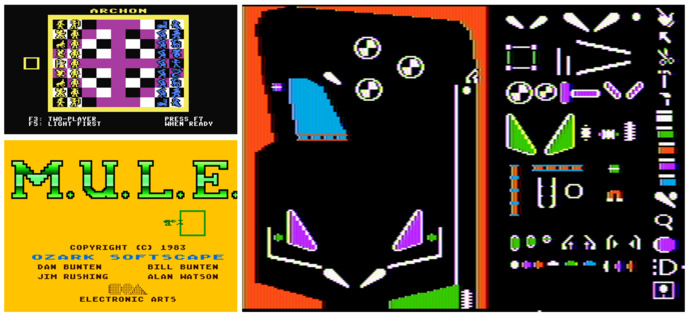
EA also published Archon: The Light and the Dark, developed by Free Fall Associates, one of my favorite games ever. Like MULE, it was developed initially for the Atari 8-bit. EA was one of the companies most focused on the Atari 8-bit, at least in 1983.
In fact, with more than 370 games released, 1983 was probably the best year for the Atari 8-bit series, almost the same amount of games released for the Apple II. But Apple II was no longer the no1 platform: in 1983, Commodore 64 surpassed the Apple II with more than 500 games released, and it was going to be the number one platform for several years.
The fourth most popular platform was the ZX Spectrum, which led the home computer revolution in the UK as the best-selling machine.
One of the games born on the Spectrum was Manic Miner, a platformer created by Matthew Smith. Spectrum users experienced a game that included sound effects and music, which was impossible on Spectrum since it has only one audio channel. This title is often included in the list of best video games of all time.
Despite the rise of popularity of the Commodore 64, the Apple II continued to be popular among game developers. Douglas E. Smith developed the platformer Lode Runner on an Apple II+ (in 6502 assembly). It was one of the first games to include a level editor.
Another Apple II loyalist was Richard Garriott, who developed Ultima III: Exodus for the Apple II. This time, he published it with his new company, Origin Systems.
The basketball game One-on-One (also known as One on One: Dr. J vs. Larry Bird) was created by Eric Hammond for the Apple II, and it was the first sports game successfully launched by EA. It became popular only when ported to the C64.
But another thing happened in 1983. In June 1983, Microsoft and ASCII announced the MSX architecture. Initially, MSX computers were supposed to be released in Japan only, but they arrived in Europe. These computers' impact on gaming would not be so huge, but some memorable titles were born on the MSX. Not many know that Bomberman (Dyna Blaster in Europe), by Hudson Soft, before becoming popular on the NES, was developed for MSX.
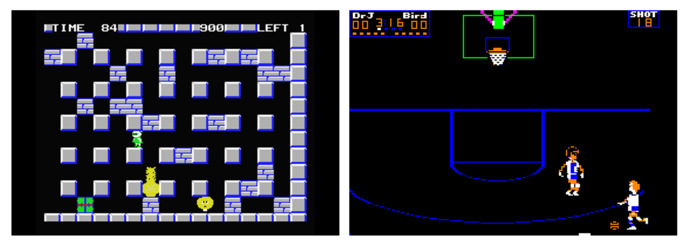
And these are just some of the titles. 1983 was really a fantastic year! But what is the most relevant computer gaming platform of 1983? Apple II was still significant but decreasing in terms of importance. The Commodore 64 was a hit, but "real" C64 games, the ones showing the capabilities of this computer, had not arrived yet.
So all considered, I like to think that the winner in 1983 was the old good Atari 8-bit, with the Apple II still very important.
1984 - The Golden Year of 8-bit Computer Games
There is probably no other year as popular as 1984 in pop culture. Movies such as Ghostbusters, Gremlins, Karate Kid, The NeverEnding Story, The Terminator were released in 1984. William Gibson published Neuromancer, inventing cyberspace and the cyberpunk genre. Marget Weis & Tracy Hickman released the first book of the famous Dragonlance Chronicles, a cult book for Dungeons & Dragons fans.
But 1984 was a unique year for computers too. 1984 started with the Apple Macintosh launch, with the famous TV commercial aired during the January Super Bowl. At the same time, IBM released the PC Jr., a model that would not make history, but it marked the arrival of the IBM PC in the gaming business. Anyway, those machines were not "for the masses." What entered the people's houses was the Commodore 64, which became the highest-selling home computer. 1984 was its best year, with at least 2.5 mln models sold (it would continue to sell two mln models per year during the '80s). Game companies could not ignore this anymore, so they targeted the C64 as their primary platform.
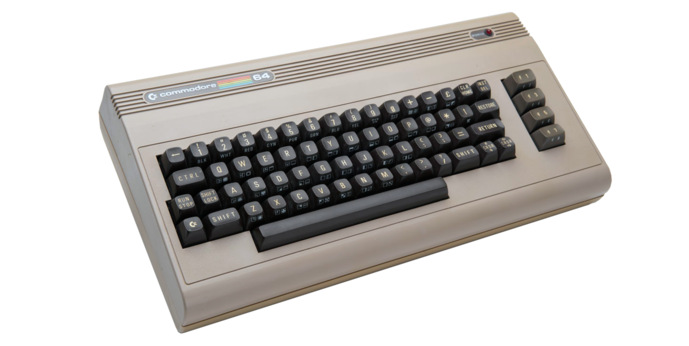
One of those companies was Automated Simulations. As you remember, they started producing the Dunjonquest series for the TRS-80 and Apple II, but in 1982 there were losing money. They saved the company, renamed Epyx, releasing the bestselling C64 game of 1983: Jumpman. It was a platformer designed by Randy Glover, vaguely inspired by Donkey Kong.
In 1984, Epyx released some of the most memorable C64 games ever created. The first was the puzzle/action-adventure Impossible Mission, designed by Dennis Caswell.
Then in June, just in time for the Los Angeles Olympic Games of 1984, they released Summer Games, one of the most advanced C64 games developed so far. With this, people were able to see what the Commodore 64 was capable of.
Epyx also released Pitstop II, a fantastic racing game for two players (I played it a lot at the time).
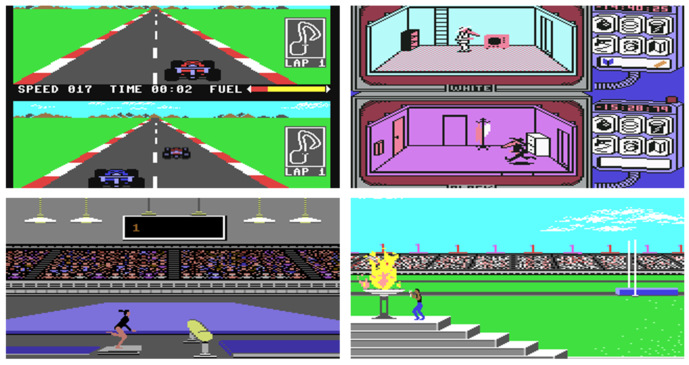
Michael J. Riedel's Spy vs Spy, published by First Star Software, was also developed for the Commodore 64.
Activision also saw the potential of the C64. David Crane, the creator of pitfall, created the iconic Ghostbusters videogame for the C64, one of the first titles to include digitized speech.
First Star Software released Boulder Dash for the Atari 8-bit computers, but the success came when ported to the C64. The same is true for Bruce Lee by Datasoft and Montezuma's Revenge by Parkers Brothers. Similar story for F-15 Strike Eagle, one of the first flight sims by Sid Meier's company MicroProse, first developed for the Atari 8-bit and then landed on C64.
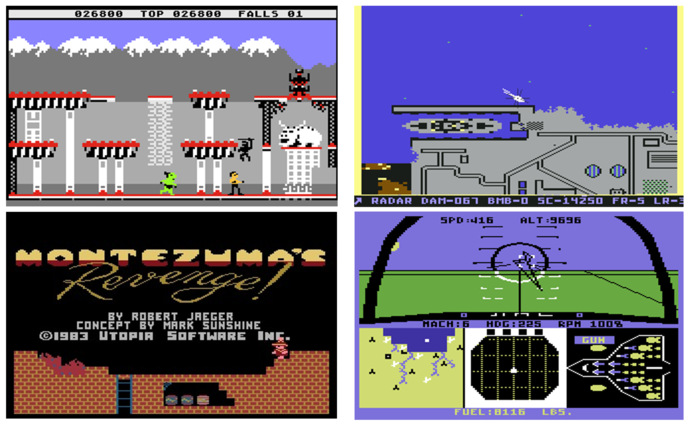
Instead, Raid on Bungeling Bay, the first game designed and programmed by Will Wright, was made originally for the Commodore 64. As we know, this game was the inspiration for SimCity.
I think it's already clear who was the star in 1984.
If Commodore 64 was the leading platform, with more than 800 games released, the ZX Spectrum and Apple II were second and third (more than 300 titles each). In England, the Stampers brothers - with their company Ultimate Play The Game - released Knight Lore for the ZX Spectrum. It was a revolutionary isometric action-adventure, and it became a huge hit.
Another memorable Spectrum game was The Lords of Midnight. This epic fantasy strategy-RPG with pseudo-3D exploration was created by Mike Singleton for the ZX Spectrum and released in 1984.
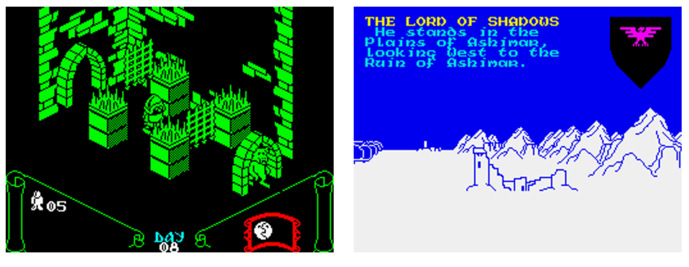
Despite the arrival of new computers, the Apple II was still a fascinating platform for many developers, and one of them was the famous Jordan Mechner. In 1984, Brøderbund released his first game, Karateka.
In 1984, Sierra On-Line was in a terrible position. They made the mistake of focusing their strategy on the VIC-20 and the TI 99/4A. But when the home computer war ended, those two models disappeared. Sierra risked a lot, but it was saved by IBM and the launch of the PCjr. IBM was looking for some games for the launch of their new PCjr. Ken Williams presented a new idea for a complete graphic adventure, with the player's avatar able to move on the screen, and they bought it. This is how King's Quest I: Quest for the Crown (and the AGI engine) was born. And this is the reason why Sierra has always targeted the PC since then.

Infocom's The Hitchhiker's Guide to the Galaxy, one of the most popular text adventures ever created, was also released in 1984.
There was also a new computer released in 1984: the Amstrad CPC. It would become relevant in the following years, with many games released but not many original ones.
Instead, we should remember the British computer BBC Micro for one of the most influential titles in the history of video games: Elite. Developed by David Braben and Ian Bell, Elite is the first 3D open-ended space trading and combat sim ever made. Bell and Braben programmed the game in assembly language and initially released it for the BBC Micro Model B.
There are so many great games released in 1984 that it's impossible to mention them all. With all these great titles, I cannot think about a more exciting year for computer games. Personally, it was the year when I started to be passionate about computers. I remember all the magazines talking about all these different machines and I was amazed. Yes, the 8-bit era was fantastic.
1985 - The Crisis
After the fast and incredible growth of 1983 and 1984, in 1985, companies realized their profits were not what they expected. Muse Software, as well as Scott Adams Adventures International, went out of business. Many small and inexperienced studios had to close.
As a consequence, the number of games released in 1985 was much lower compared to 1984. But it was not the end. It was just the return to reality, and new things were starting. Westwood Studios, for example, and Cinemaware were founded in 1985.
But let's proceed in order.
Commodore 64 was still the favored platform in 1985, with more than 500 games released, and some of them were amazing:
In May, Australian company Beam Software (Melbourne House) released Kung-Fu: The Way of the Exploding Fist. The two-player martial arts game designed by Gregg Barnett, and created initially for the C64, defined the genre of one-on-one fighting games. It became the best-selling computer game of 1985 in the UK and was voted Game of the Year award at the Golden Joystick Awards.
In September, Activision released Little Computer People by David Crane, the first social simulation game, a title that inspired The Sims.

Less known but still significant was Cauldron, the game that made Palace Software famous. The puzzle/shooter Paradroid created by Andrew Braybrook was also released in 1985 for the C64. Silent Service, the submarine simulator designed by Sid Meier, was also released in 1985. Sid Meier himself programmed the C64 version.
Instead, Paul Woakes created the 3D wireframe exploration game Mercenary: Escape from Targ for the Atari 8-bit. Also, Rescue of Fractalus, one of the first games created by Lucasfilm Games, was developed for the Atari 8-bit.
What about the Apple II? In 1985 Electronic Arts released The Bard's Tale. Michael Cranford created it for the Apple II, but the game was immediately ported to the Commodore 64, and it was a huge success.
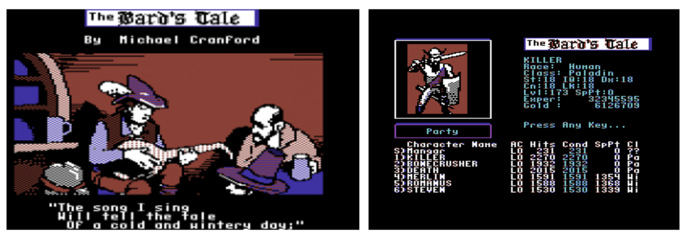
The Bard's Tale marked the decline of the Wizardry series, becoming the only competitor of Ultima IV: Quest of the Avatar, released that year.
But there was another title, born in 1985 on the Apple II, still well known today.
Where in the World Is Carmen Sandiego? was released in 1985 by Brøderbund Software for the Apple II. The title designed by Dane Bigham, Gene Portwood, and Lauren Elliott set a new standard for educational games and created a franchise that still lives today.
Again, there are so many other games, and it's impossible to mention them all. What is clear is that the Commodore 64 was now the most influential platform, even if some of the best titles were still developed first for the Apple II or Atari 8-bit.
1986 - The Restart and the Beginning of the Transition
In 1986 the market restarted to grow. Commodore 64 was still the first platform, with almost 600 games released, but the competition grew: more than 400 games for the ZX Spectrum and nearly the same for the Amstrad CPC. The fourth platform was now MS-DOS, which surpassed MSX. But it's not all. Let's start with some games released this year.
MicroProse released the revolutionary helicopter simulator Gunship. EA and Interplay released The Bard's Tale II: The Destiny Knight. Created initially for the C64, it features a much bigger world compared to the precursor.
The British company System3 originally created International Karate for the ZX Spectrum in 1985, but it became famous in 1986 when ported to the C64. I know we were all mad about martial arts in the 80s, but this is one of the best games ever released. The music by Rob Hubbard is legendary, not to mention the fantastic animations designed by Archer Maclean. System3 will continue working on the C64, creating some of the best games ever seen on this platform.
Like Elite, Geoff Crammond's Formula Three simulation Revs was also developed originally for the BBC Micro. It was a revolutionary driving simulation with three-dimensional tracks (not flat) and realistic physics. It was the precursor of the famous Formula 1 Grand Prix. It was initially created in 1984, then improved with new tracks and released by Firebird in February 1986 for the Commodore 64.
Geoff Crammond also created The Sentinel, released in 1986 for the BBC Micro and converted by Crammond himself for the C64. It was the first game with 3d filled polygon graphics.
Electronic Arts published the open-ended space exploration game Starflight in August 1986 for the IBM-PC. This game will end up selling 1mln copies, and it inspired the famous Star Control II.
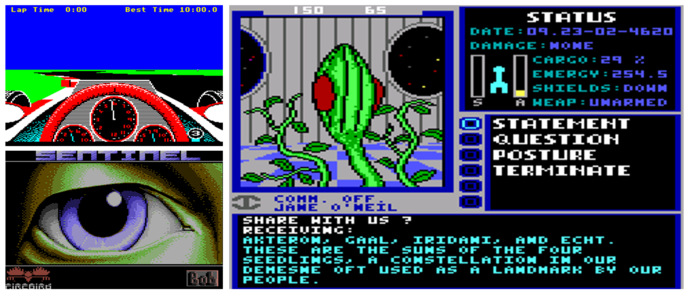
Sierra released the third chapter of King's Quest and started a new series with Space Quest I: Roger Wilco in the Sarien Encounter. Created by Scott Murphy and Mark Crowe, the new comedy sci-fi adventure became as important as King's Quest, if not more.
Talking about adventures, in 1986, Infocom released one of its best titles: Leather Goddesses of Phobos by Steve Meretzky, an adult-only space pulp adventure.
Not many know that the first adventure created by Lucasfilm Games was Labyrinth. Based on the Jim Henson movies, the game was released in 1986 for the C64 and Apple II. It was not using the SCUMM engine yet (created in 1987 for Maniac Mansion) but a wheel system to select verbs and nouns.
Another series that was launched in 1986 is Might and Magic. Jon Van Caneghem worked 3 years to create the first Apple II version of his RPG, finally released in 1986. Due to its success, it was ported to all possible platforms, and as we know, it generated many sequels and spin-offs.
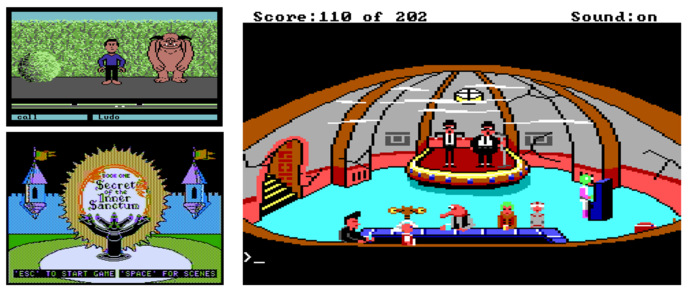
Apparently, not much was changed. Most games were developed for the C64 or for other 8-bit platforms and then ported to C64. But there are also the first hits that were not available for Commodore 64 users: Space Quest will never see a C64 version, and Starflight would be ported only in 1989. The "PC only" trend was just starting...
But two more platforms were born, and they will compete with the IBM PC in the following years.
Announced in January 1985, the Atari ST started to be sold in Summer 1985. With a Motorola 68000 processor, 512 KB RAM, 320x200 16colors screen resolution, advanced music, and sound, it was way better than any 8-bit computer.
Almost at the same time, in July 1985, Commodore introduced the Amiga 1000, with a big event starring Andy Warhol and Debbie Harry. The basic specs looked similar to the Atari ST, but the Amiga had dedicated co-processors, more colors, and a full multitasking operative system. It was truly a computer ahead of its time.
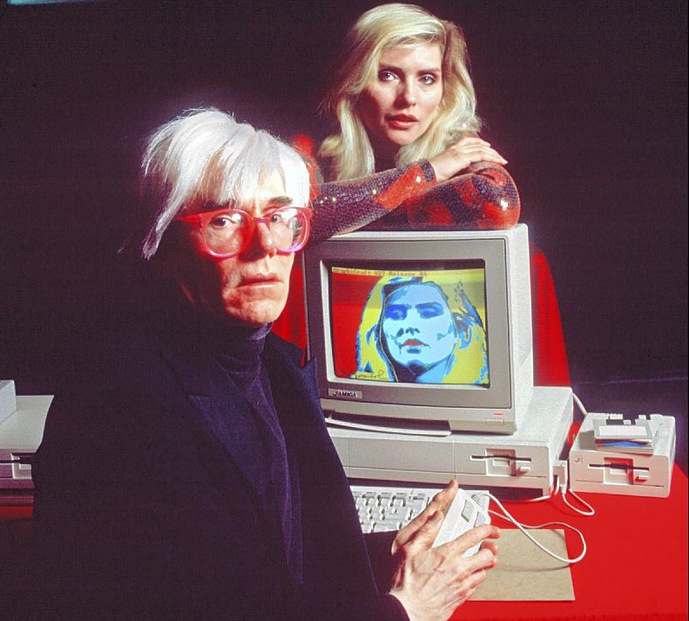
The Amiga didn't really become popular until the Amiga 500 in 1987, but in 1986 we started to see the first games.
One of the first ones was Mind Walker, created by Bill Williams. It was a brilliant 3D puzzle platformer and probably the first real game for the Amiga 1000.
But the real revelation, the game that set a new standard in terms of video games, was Defender of the Crown. The title designed by Kellyn Beck was the first published by Cinemaware. When people saw Defender of the Crown in September 1986, they stood speechless. It was the first game properly using the graphics of the Amiga. If you compare the screenshots of Defender of the Crown with any other game mentioned so far in this article, you can understand how this game was simply another league.
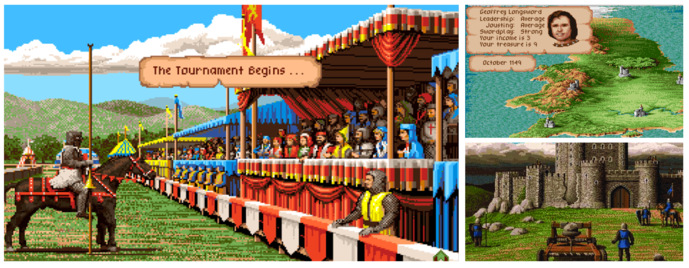
That day, the world of computer games changed forever. There will be more great 8-bit games released during the following years, and the Commodore 64 will dominate a few more years, but the future was here as Jimmy Maher would say.
This second part ends here. In the next part, we will see the decline of the 8-bit era and the rise of the new trinity: Amiga, Atari ST, and PC.
